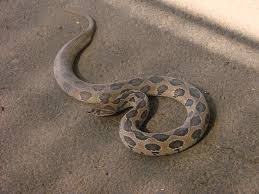Russell’s Viper:

Studies carried out in mice have demonstrated that two approved drugs — varespladib and marimastat — were effective in countering systemic and lethal effects of Russell’s viper (Daboia russelii) venom either individually or in combination.
Highlight of the study:
- Phospholipase A2(PLA2), and Snake Venom Metalloproteinase (SVMPs) are two main components of Russell’s viper snake venom.
- These toxins interfere with components of the blood clotting cascade to induce anticoagulant and haemorrhagic effects in humans. While the varespladib drug inhibits PLA2, the marimastat drug inhibits SVMP.
- The PLA2 inhibitor varespladib was found to neutralise even the high PLA2 activity of the venom found in Tamil Nadu and Punjab.
- The varespladib drug effectively inhibited the modest PLA2 activity of the venom from other Indian regions.
Russell’s Viper:
- It is a highly venomous terrestrial snake of the family Viperidae found in Asia.
- It is one of the big four snakes (deadliest snakes) in India, the others being the Common krait (Bungarus caeruleus), the Indian Cobra (Naja naja) and the Saw-scaled viper (Echis carinatus).
- Russell’s vipers are responsible for over half of India’s snakebite cases.
- They tend to avoid dense forests.
- They are mostly found in open, grassy, or bushy areas, but may also be found in second-growth forests (scrub jungles), on forested plantations, and on farmland.
- It is found in India, Sri Lanka, Bangladesh, Nepal, Myanmar, Thailand, Pakistan, Cambodia, Tibet, China (Guangxi, Guangdong), Taiwan, and Indonesia.
- The snake can grow up to 1.5 meters and is identified by its distinctive reddish-brown spots outlined in black and white.
- It has a wide, triangular head with small, overlapping scales, large nostrils, and small eyes with vertical pupils.
- It is mainly nocturnal, becoming active as the sun fades.
- These snakes are quite sedentary, often staying in one place for several days unless disturbed.
- Conservations Status: IUCN Red List: Least Concern




